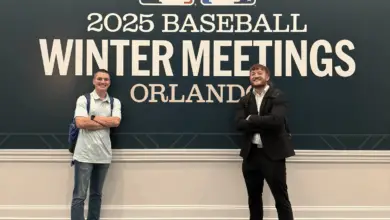
David Dahl Would Be Solid Replacement if Cubs Don’t Extend Kyle Schwarber
Even though Jed Hoyer said Wednesday that the door remains open to bringing back “Cubs legend” Kyle Schwarber, it’s entirely possible the slugger will have to be replaced in left field and the lineup. No matter who’s playing left, even if it’s Schwarber on a return engagement, you can bet they’ll be making less than his projected $8 million arbitration salary. How much less may determine which direction the Cubs take.
Enter David Dahl, who was not tendered a 2021 contract offer by the Rockies and is now a free agent heading into a season in which he was projected to earn around $2.5 million. The 10th overall pick in 2012, Dahl is actually a year younger than Schwarber because he was drafted right out of Oak Mountain High School in Birmingham. A disastrous 2020 campaign and a relatively low ceiling made him expendable, but he profiles as a decent fit in Chicago.
First, the negatives. Dahl isn’t a great contact hitter and his career 15% swinging-strike rate is three points worse than Schwarber even if his overall strikeout rate is two points better. He’s also hit a total of 38 homers over 1,020 plate appearances, whereas Schwarber hit that many in 2019 alone. Dahl’s defense is mediocre at best and his arm isn’t very strong, so you’re looking at a wash or even a step down there.
At the same time, Dahl offers more flexibility because he can play all three outfield positions. He’s also posted less disparate splits as a left-handed hitter with an 81 wRC+ against lefties and a 109 against righties. Perhaps the most notable stat that jumps out is Dahl’s career .494 slugging percentage, which is actually 14 points higher than Schwarber’s and would be even more so if not for the abysmal .247 he put up this past season.
Though he’s not particularly speedy and lacks prodigious power, Dahl is more of a line-drive hitter who racks up extra base hits at a higher rate than Schwarber. Their career groundball rates are nearly identical, so the difference in their batted-ball profiles comes down to about 6% in liners vs. flies. That might not seem like a lot, but the picture gets a little clearer when you see that Dahl has historically produced a little less soft contact.
Hard line drives are more likely to fall for hits, hence a career .358 BABIP for Dahl that is 91 points higher than the man he’d be replacing. Translating all of this to actual stats, we get a career average of one extra base hit every 8.93 at-bats for Dahl and every 9.03 for Schwarber. That’s admittedly a very nominal difference and features less potential for boom, though it also helps to mitigate the chances of going bust.
Finally, I am obligated to point out a marked improvement over what has become my most notable gripe with Schwarber’s plate approach: Looking at strike three. I probably make a bigger deal out of it because it’s been my pet peeve for years now, but called third strikes account for 25.2% of Schwarber’s career strikeouts. Dahl is at 19.2%, nearly four points better than league average. He may swing and miss more frequently, but he also fouls off more pitches and puts himself in a better position to make things happen with two strikes
By no means am I trying to say that Dahl is a better player than Schwarber on paper because the numbers simply don’t bear that out. However, his particular skillset at a cost of roughly three times less might make him a better fit for what this particular Cubs team needs right now.

